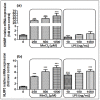Blockage of KHSRP-NLRP3 by MCC950 Can Reverse the Effect of Manganese-Induced Neuroinflammation in N2a Cells and Rat Brain
- PMID: 36362011
- PMCID: PMC9658363
- DOI: 10.3390/ijms232113224
Blockage of KHSRP-NLRP3 by MCC950 Can Reverse the Effect of Manganese-Induced Neuroinflammation in N2a Cells and Rat Brain
Abstract
Manganese neurotoxicity has been reported to cause a neurodegenerative disease known as parkinsonism. Previous reports have shown that the expression of the KH-type splicing regulatory protein (KHSRP), a nucleic acid-binding protein, and NLRP3 is increased upon Mn exposure. However, the relation between these two during Mn toxicity has not been fully deduced. The mouse neuroblastoma (N2a) and SD rats are treated with LPS and MnCl2 to evaluate the expression of KHSRP and NLRP3. Further, the effect of the NLRP3 inhibitor MCC950 is checked on the expression of NLRP3, KHSRP and pro-inflammatory markers (TNFα, IL-18 and IL-1β) as well as the caspase-1 enzyme. Our results demonstrated an increment in NLRP3 and KHSRP expression post-MnCl2 exposure in N2a cells and rat brain, while on the other hand with LPS exposure only NLRP3 expression levels were elevated and KHSRP was found to be unaffected. An increased expression of KHSRP, NLRP3, pro-inflammatory markers and the caspase-1 enzyme was observed to be inhibited with MCC950 treatment in MnCl2-exposed cells and rats. Manganese exposure induces NLRP3 and KHSRP expression to induce neuroinflammation, suggesting a correlation between both which functions in toxicity-related pathways. Furthermore, MCC950 treatment reversed the role of KHSRP from anti-inflammatory to pro-inflammatory.
Keywords: KHSRP; N2a cells; Parkinson’s; manganese neurotoxicity; neuroinflammation.
Conflict of interest statement
All the authors declare no conflict of interest.
Figures












Similar articles
-
[Effects of MCC950 on nerve injury in rats with intracerebral hemorrhage].Zhongguo Ying Yong Sheng Li Xue Za Zhi. 2022 Jan;38(1):11-16. doi: 10.12047/j.cjap.6191.2022.003. Zhongguo Ying Yong Sheng Li Xue Za Zhi. 2022. PMID: 35634663 Chinese.
-
Inhibition of the NLRP3/caspase-1 cascade related pyroptosis relieved propofol-induced neuroinflammation and cognitive impairment in developing rats.Free Radic Biol Med. 2024 Nov 20;225:87-97. doi: 10.1016/j.freeradbiomed.2024.09.038. Epub 2024 Sep 26. Free Radic Biol Med. 2024. PMID: 39341300
-
[Effect of electroacupuncture regulating NLRP3/Caspase-1 pathway on pyroptosis of dopaminergic neurons in rats with Parkinson's disease].Zhen Ci Yan Jiu. 2022 Nov 25;47(11):983-92. doi: 10.13702/j.1000-0607.20211016. Zhen Ci Yan Jiu. 2022. PMID: 36453675 Chinese.
-
NLRP3 inflammasome up-regulates major histocompatibility complex class I expression and promotes inflammatory infiltration in polymyositis.BMC Immunol. 2022 Aug 14;23(1):39. doi: 10.1186/s12865-022-00515-2. BMC Immunol. 2022. PMID: 35965334 Free PMC article.
-
Ameliorative effect of selective NLRP3 inflammasome inhibitor MCC950 in an ovalbumin-induced allergic rhinitis murine model.Int Immunopharmacol. 2020 Jun;83:106394. doi: 10.1016/j.intimp.2020.106394. Epub 2020 Mar 16. Int Immunopharmacol. 2020. PMID: 32193102
Cited by
-
Signaling Pathways Involved in Manganese-Induced Neurotoxicity.Cells. 2023 Dec 14;12(24):2842. doi: 10.3390/cells12242842. Cells. 2023. PMID: 38132161 Free PMC article. Review.
-
Force-induced Caspase-1-dependent pyroptosis regulates orthodontic tooth movement.Int J Oral Sci. 2024 Jan 15;16(1):3. doi: 10.1038/s41368-023-00268-7. Int J Oral Sci. 2024. PMID: 38221531 Free PMC article.
-
Using Small Molecules for Targeting Heavy Metals in Neurotoxicity and Neuroinflammation.Methods Mol Biol. 2024;2761:135-148. doi: 10.1007/978-1-0716-3662-6_11. Methods Mol Biol. 2024. PMID: 38427235
-
Farnesol Protects against Cardiotoxicity Caused by Doxorubicin-Induced Stress, Inflammation, and Cell Death: An In Vivo Study in Wistar Rats.Molecules. 2022 Dec 6;27(23):8589. doi: 10.3390/molecules27238589. Molecules. 2022. PMID: 36500681 Free PMC article.
-
MAPK signaling mediates tamoxifen resistance in estrogen receptor-positive breast cancer.Mol Cell Biochem. 2025 May 23. doi: 10.1007/s11010-025-05304-0. Online ahead of print. Mol Cell Biochem. 2025. PMID: 40410609 Review.
References
-
- Rybakowska I., Kaletha K., Anand J.S. Manganism–Neurodegenerative Brain Disease Caused by Poisoning with Manganese. Prz. Lek. 2012;69:555–556. - PubMed
-
- Ávila D.S., Puntel R.L., Folmer V., Rocha J.B.T., dos Santos A.P.M., Aschner M. Manganese Neurotoxicity. In: Kostrzewa R.M., editor. Handbook of Neurotoxicity. Springer; New York, NY, USA: 2014. pp. 843–864.
MeSH terms
Substances
Grants and funding
LinkOut - more resources
Full Text Sources
Miscellaneous

